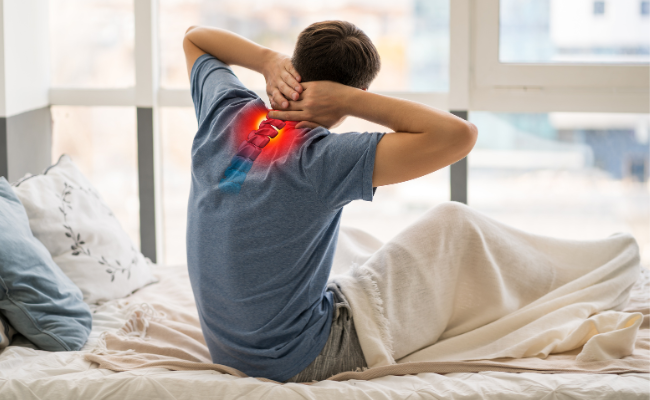How to Treat Cervical Spondylosis?
- February 14, 2024
- No Comments

What is Cervical Spondylosis?
Spondylosis is a general term for age-related wear and tear of the spinal discs, which commonly worsens as people get older. This condition, often referred to as degenerative arthritis or osteoarthritis of the spine, can affect various parts of the spine, including the cervical spine or neck area. When it affects the neck, it's called cervical spondylosis or neck arthritis. Over time, the cartilage and bones in the neck undergo wear and tear, leading to stiffness, pain, and sometimes numbness or weakness in the arms or hands. While many people with spondylosis may not experience any symptoms, some may feel pain or muscle spasms, particularly as the condition progresses with age.
Why Does Cervical Spondylosis Occur?
Several factors contribute to the development of cervical spondylosis. Age is a significant factor, as the wear and tear on the cervical spine increase with time. Other factors include repetitive neck movements, poor posture, genetic predisposition, and injuries such as fractures or dislocations.
How Does Cervical Spondylosis Manifest?
Cervical spondylosis can manifest through various symptoms, which may include:
- Neck pain: Persistent or intermittent pain in the neck, often worsened by movement.
- Stiffness: Difficulty in moving the neck, especially after prolonged periods of inactivity.
- Headaches: Pain that radiates from the neck to the back of the head.
- Numbness or weakness: Tingling sensations, numbness, or weakness in the arms or hands.
- Loss of balance: Difficulty in maintaining balance or coordination, particularly in severe cases.
Treatment Solutions for Cervical Spondylosis
- Medications: Nonsteroidal anti-inflammatory drugs (NSAIDs) such as ibuprofen or naproxen can help alleviate pain and reduce inflammation. Muscle relaxants may also be prescribed to relieve muscle spasms.
- Physical Therapy: Exercises and stretches prescribed by a physical therapist can help improve flexibility, strength, and posture. Techniques such as cervical traction may also be utilized to alleviate pressure on the spine.
- Heat and Cold Therapy: Applying heat packs or cold packs to the affected area can help reduce pain and inflammation. Alternating between heat and cold therapy may provide further relief.
- Cervical Collars: In some cases, wearing a cervical collar for short periods may help support the neck and relieve pressure on the spine. However, prolonged use of cervical collars is not recommended as it can weaken the neck muscles.
- Steroid Injections: Corticosteroid injections directly into the affected area can provide temporary relief from pain and inflammation, especially for individuals with severe symptoms.
- Surgery: Surgery may be recommended for individuals with severe cervical spondylosis who do not respond to conservative treatments. Surgical options include discectomy, laminectomy, or spinal fusion to decompress nerves or stabilize the spine.
Benefits of Treating Cervical Spondylosis
- Pain Relief: One of the primary benefits of treating cervical spondylosis is the alleviation of neck pain. Chronic neck pain can significantly impact daily activities, work productivity, and overall well-being. By addressing the underlying causes of pain through various treatment modalities, individuals can experience relief and regain comfort in their neck region.
- Improved Mobility: Cervical spondylosis often leads to stiffness and restricted movement in the neck. Through targeted physical therapy exercises, stretches, and other interventions, individuals can improve their neck flexibility and range of motion. Enhanced mobility enables individuals to perform daily tasks with greater ease and comfort.
- Prevention of Nerve Compression: As cervical spondylosis progresses, it can sometimes lead to nerve compression or irritation, resulting in symptoms such as numbness, tingling, or weakness in the arms or hands. Timely treatment helps alleviate pressure on the nerves, preventing further damage and reducing the risk of long-term complications.
- Enhanced Posture: Poor posture is a common contributing factor to cervical spondylosis. Physical therapy and targeted exercises not only help alleviate pain but also promote proper alignment of the spine and improve posture. Correcting posture reduces strain on the neck muscles and vertebrae, contributing to long-term spinal health.
- Increased Functionality: By effectively managing cervical spondylosis, individuals can regain lost functionality and resume activities they may have avoided due to pain or discomfort. Whether it's working at a computer, engaging in sports or recreational activities, or simply enjoying hobbies, improved neck health enhances overall functionality and participation in daily life.
- Better Sleep Quality: Chronic neck pain associated with cervical spondylosis can disrupt sleep patterns and lead to sleep disturbances. By addressing pain and discomfort through treatment, individuals can experience improved sleep quality and better restorative sleep, leading to increased energy levels and overall well-being.
- Reduced Reliance on Medications: While medications such as pain relievers and muscle relaxants may provide temporary relief from cervical spondylosis symptoms, long-term reliance on medication can have adverse effects. Effective treatment strategies aim to address the root causes of pain and discomfort, reducing the need for ongoing medication use and minimizing potential side effects.
- Psychological Well-being: Chronic pain conditions like cervical spondylosis can take a toll on mental health, leading to anxiety, depression, or decreased quality of life. By effectively managing symptoms and improving physical function, individuals experience a boost in psychological well-being, leading to greater confidence, resilience, and overall satisfaction with life.
Comments (0)